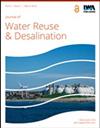可漂浮二氧化钛催化剂在污水中光催化降解碳氢化合物和亚甲基蓝
IF 2.3
Q2 Environmental Science
引用次数: 22
摘要
光催化分解是一种新型的污染治理方法。该方法利用半导体二氧化钛在紫外线(UV)光的存在下降解有机分子。在这项研究中,它显示了几种类型的催化剂设计如何降解非极性物质柴油和极性物质亚甲基蓝的能力。泡沫玻璃涂覆二氧化钛浮式设计可在16 h内降低柴油浓度329 mg/L;涂覆玻璃纤维浸没设计和涂覆钢砂浸没设计在4 h和6 h后亚甲蓝浓度分别降低96.6%和99.1%。由此可见,光催化是一种极具成本效益的治理空气和水污染的方法。它可以作为一种低技术含量的方法,不需要使用传统的能源,只要有足够的日照时间,或者作为水处理厂使用uv - led的额外清洁阶段。本文章由计算机程序翻译,如有差异,请以英文原文为准。
Photocatalytic degradation of hydrocarbons and methylene blue using floatable titanium dioxide catalysts in contaminated water
Photocatalytic disintegration is a novel approach to eliminate pollution. The method utilizes the semiconductor titanium dioxide to degrade organic molecules in the presence of ultraviolet (UV) light. In this study, it is shown how the capabilities of several types of catalyst designs degrade the non-polar substance diesel fuel and the polar substance methylene blue. The floating design of foam glass coated with titanium dioxide could reduce the concentration of diesel fuel by 329 mg/L in 16 h; the submerged designs for coated glass fiber and coated steel grit could reduce methylene blue concentration by 96.6% after 4 h and 99.1% after 6 h, respectively. It could be shown that photocatalysis is a promising cost- and energy-efficient method for managing air and water pollution. It can be established as a low-technology method without requiring the use of a conventional source of energy, given an adequate amount of sun hours, or as an additional cleaning stage in water treatment plants using UV-LEDs.
求助全文
通过发布文献求助,成功后即可免费获取论文全文。
去求助
来源期刊

Journal of Water Reuse and Desalination
ENGINEERING, ENVIRONMENTAL-WATER RESOURCES
CiteScore
4.30
自引率
0.00%
发文量
23
审稿时长
16 weeks
期刊介绍:
Journal of Water Reuse and Desalination publishes refereed review articles, theoretical and experimental research papers, new findings and issues of unplanned and planned reuse. The journal welcomes contributions from developing and developed countries.
 求助内容:
求助内容: 应助结果提醒方式:
应助结果提醒方式:


